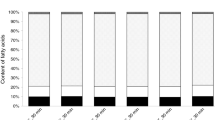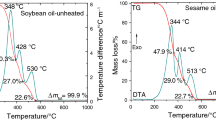Abstract
Physico-chemical properties, spectroscopy, and thermal analyses were used aiming at evaluating the influence of toasting and of the flaxseed variety on thermo-oxidative behavior of flaxseed oils. Thermogravimetry (TG) and differential scanning calorimetry (DSC) were associated to gas chromatography, infrared spectroscopy and UV–Vis spectroscopy, as well as to physico-chemical analyses to characterize the oils obtained from raw and toasted flaxseeds. No meaningful differences in the thermal and oxidative stabilities were noticed comparing oils obtained from the brown and the golden flaxseeds. Nevertheless, the UV–Vis spectra indicated that both flaxseed oils were at the beginning of the oxidation process. The previous toasting of the seeds led to a higher oxidation for both varieties being harmful to the flaxseed oil quality.


Similar content being viewed by others
References
Morris DH. Flax: a health and nutrition primer. 4th ed. Winnipeg: Flax Council of Canada; 2007.
Adkins Y, Kelley D. Mechanisms underlying the cardioprotective effects of omega-3 polyunsaturated fatty acids. J Nutr Biochem. 2010;21:789–92.
Lazko J, Dupré B, Dheilly RM, Quéneudec M. Biocomposites based on flax short fibres and linseed oil. Ind Crop Prod. 2011;33:317–24.
Araújo KLGV, Epaminondas PS, Silva MCD, Lima AEA, Rosenhaim R, Maia AS, Soledade LEB, Souza AL, Santos IMG, Souza AG, Queiroz N. Influence of thermal degradation in the physicochemical properties of fish oil. J Therm Anal Calorim 2011; doi 10.1007/s10973-011-1409-9.
Embaby HES. Effect of heat treatments on certain antinutrients and in vitro protein digestibility of peanut and sesame seeds. Food Sci Technol Res. 2011;17:31–8.
Wu M, Li D, Wang L, Zhou Y, Brooks MS, Chen XD, Mao Z. Extrusion detoxification technique on flaxseed by uniform design optimization. Sep Purif Technol. 2008;61:51–9.
Maia EL, Rodriguez-Amaya DB. Evaluation of a simple and economic method for the methylation of fatty acids with lipids of several fish species. Rev Inst Adolfo Lutz. 1993;53:27–35.
American Oil Chemists’ Society. Official methods and recommended practices of the American Oil Chemists’ Society. 4th ed. Champaign: AOCS Press; 1995.
Firestone D. Physical and chemical characteristics of oils, fats, and waxes. 2nd ed. Champaign: AOCS Press; 2006.
Choo WS, Birch J, Dufour JP. Physicochemical and quality characteristics of cold-press flaxseed oils. J Food Compos Anal. 2007;20:202–11.
Benedikt R. Chemical analysis of oils, fats, waxes, and of the commercial products derived therefrom. Alcester: Read Books; 2007.
Hui YH. Handbook of food science, technology, and engineering. Boca Raton: CRC Press; 2006.
Sikorski ZZE, Kolakowska A. Chemical and functional properties of food lipids. Boca Raton: CRC Press; 2002.
Przybylski R. Flax oil and high linolenic oils. In: Shahidi F, editor. Bailey’s industrial oil and fat products. 6th ed. Hoboken: Wiley-Interscience; 2005. p. 281–301.
Codex alimentarius. Norma del codex para aceites vegetales especificados. In: Food and Agriculture Organization of the United Nations. Codex stan 210. 2005. http://www.codexalimentarius.net/download/standards/336/CXS_210s.pdf. Accessed 17 June 2009.
Lopes WA, Fascio M. Flow chart for infrared spectra interpretation of organic compounds. Quim Nova. 2004;27:670–3.
Ribeiro CMR, Souza NA. General scheme for elucidating the structure of organic compounds using spectroscopic and spectrometric methods. Quim Nova. 2007;30:1026–31.
Skoog DA, West DM, Holler FJ, Crouch SL. Fundamentals of analytical chemistry. 8th ed. Belmont: Cengage Learning; 2004.
Rudnik E, Szczucinska A, Gwardiak H, Szulc A, Winiarska A. Comparative studies of oxidative stability of linseed oil. Thermochim Acta. 2001;370:135–40.
Cämmerer B, Kroh LW. Shelf life of linseeds and peanuts in relation to roasting. Food Sci Technol. 2009;42:545–9.
Acknowledgements
The authors acknowledge the Brazilian Agencies National Council for Scientific and Technological Development (CNPq) and Coordination for the Improvement of Higher Education Personnel (CAPES) for the financial support.
Author information
Authors and Affiliations
Corresponding author
Rights and permissions
About this article
Cite this article
Epaminondas, P.S., Araújo, K.L.G.V., Nascimento, J.A. et al. Influence of toasting and the seed variety on the physico-chemical and thermo-oxidative characteristics of the flaxseed oil. J Therm Anal Calorim 106, 545–550 (2011). https://doi.org/10.1007/s10973-011-1731-2
Published:
Issue Date:
DOI: https://doi.org/10.1007/s10973-011-1731-2




